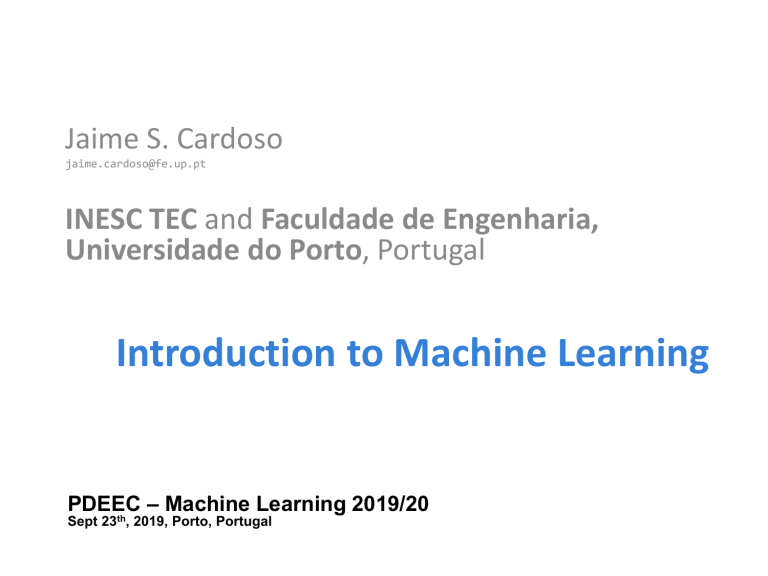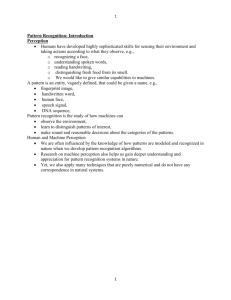
Jaime S. Cardoso
jaime.cardoso@fe.up.pt
INESC TEC and Faculdade de Engenharia,
Universidade do Porto, Portugal
Introduction to Machine Learning
PDEEC – Machine Learning 2019/20
Sept 23th, 2019, Porto, Portugal
Roadmap
•
•
•
•
What’s Machine Learning
Distinct Learning Problems
For the same problem, different solutions
Different solutions but with common traits
– … and ingredients
•
•
•
•
Avoiding overfitting and data memorization
A fair judgement of your algorithm
Some classical ML algorithms
Beyond the classics
2
Artificial Intelligence (AI)
• “ […automation of] activities that we
associate with human thinking, activities such
as decision-making, problem solving,
learning…” (Bellman, 1978)
• “ The branch of computer science that is
concerned with the automation of intelligent
behaviour.” (Luger and Stubblefield, 1993)
• “The ultimate goal of AI is to create
technology that allows computational
machines to function in a highly intelligent
manner. (Li Deng 2018)
3
AI: three generations
1st wave of AI: the sixties
• emulates the decision-making process of a
human expert
Program
Computer
Output
Data
4
AI: three generations
1st wave of AI: the sixties
• Based on expert knowledge
– “if-then-else”
• Effective in narrow-domain problems
• Focus on the head or most important parameters
(identified in advance), leaving the “tail” parameters
and cases untouched.
•
•
•
•
Transparent and interpretable
Difficulty in generalizing to new situations and domains
Cannot handle uncertainty
Lack the ability to learn algorithmically from data
5
AI: three generations
2nd wave of AI: the eighties
• Based on (shallow) machine learning
Data
Output
Machine
Learning
Program
Program
Computer
Output
Data
6
An example*
• Problem: sorting incoming
fish on a conveyor belt
according to species
• Assume that we have only
two kinds of fish:
– Salmon
– Sea bass
*Adapted from Duda, Hart and Stork, Pattern Classification, 2nd Ed.
7
An example: decision process
• What kind of information can distinguish one species
from the other?
– Length, width, weight, number and shape of fins, tail
shape, etc.
• What can cause problems during sensing?
– Lighting conditions, position of fish on the conveyor belt,
camera noise, etc.
• What are the steps in the process?
– Capture image -> isolate fish -> take measurements ->
make decision
8
An example: our system
• Sensor
– The camera captures an image as a new fish enters the sorting area
• Preprocessing
– Adjustments for average intensity levels
– Segmentation to separate fish from background
• Feature Extraction
– Assume a fisherman told us that a sea bass is generally longer than a salmon. We
can use length as a feature and decide between sea bass and salmon according to a
threshold on length.
Sensor
Pixels
input
Filtering
Features
Decisions
9
An example: features
We estimate the system’s probability of error and obtain a
discouraging result of 40%. Can we improve this result? 10
An example: features
• Even though sea bass is longer than salmon on the
average, there are many examples of fish where this
observation does not hold
• Committed to achieve a higher recognition rate, we
try a number of features
– Width, Area, Position of the eyes w.r.t. mouth...
– only to find out that these features contain no
discriminatory information
• Finally we find a “good” feature: average intensity of
the fish scales
11
An example: features
Histogram of the lightness feature for two types of fish in
training samples. It looks easier to choose the threshold but
we still can not make a perfect decision.
12
An example: multiple features
• We can use two features in our decision:
– lightness: 𝒙1
– length: 𝒙2
• Each fish image is now represented as a point
(feature vector)
é x1 ù
x =ê ú
ë x2 û
in a two-dimensional feature space.
13
An example: multiple features
Scatter plot of lightness and length features for training samples. We
can compute a decision boundary to divide the feature space into
two regions with a classification rate of 95.7%.
14
An example: cost of error
• We should also consider costs of different errors we
make in our decisions.
• For example, if the fish packing company knows that:
– Customers who buy salmon will object vigorously if they
see sea bass in their cans.
– Customers who buy sea bass will not be unhappy if they
occasionally see some expensive salmon in their cans.
• How does this knowledge affect our decision?
15
An example: cost of error
We could intuitively shift the decision boundary to
minimize an alternative cost function
16
An example: generalization
• The issue of generalization
– The recognition rate of our linear classifier (95.7%) met the
design specifications, but we still think we can improve the
performance of the system
– We then design a classifier that obtains an impressive
classification rate of 99.9975% with the following decision
boundary
17
Data Driven Design
• When to use?
– Difficult to reason about a generic rule that solves
the problem
– Easy to collect examples (with the solution)
Length
18
Data Driven Design
• There is little or no domain theory
• Thus the system will learn (i.e., generalize)
from training data the general input-output
function
Programming computers to use example data or past
experience
• The system produces a program that
implements a function that assigns the
decision to any observation (and not just the
input-output patterns of the training data)
19
What is Machine Learning?
• Automating the Automation
Data
Computer
Output
Program
Data
Output
Machine
Learning
Program
20
Data Driven Design
• A good learning program learns something
about the data beyond the specific cases that
have been presented to it
– Indeed, it is trivial to just store and retrieve the
cases that have been seen in the past
• This does not address the problem of how to handle
new cases, however
• Over-fitting a model to the data means that
instead of general properties of the
population we learn idiosyncracies (i.e., nonrepresentative properties) of the sample.
21
DISTINCT LEARNING PROBLEMS
22
Taxonomy of the Learning Settings
Goals and available data dictate the type of learning problem
• Supervised Learning
– Classification
• Binary
• Multiclass
– Nominal
– Ordinal
– Regression
– Ranking
– Counting
•
•
•
•
Semi-supervised Learning
Unsupervised Learning
Reinforcement Learning
etc.
23
Supervised Learning: Examples
24
Classification/Regression
y = f(x)
output prediction
function
feature
vector
• Training: given a training set of labeled examples {(x1,y1), …,
(xN,yN)}, estimate the prediction function f by minimizing the
prediction error on the training set
• Testing: apply f to a never before seen test example x and
output the predicted value y = f(x)
25
Regression
• Predicting house price
– Output: price (a scalar)
– Inputs: size, orientation, localization, distance to key
services, etc.
• Given a collection of labelled examples (= houses
with known price), come up with a function that
will predict the price of new examples (houses).
26
Supervised Learning
in computer vision
Training
Training
Labels
Training
Images
Image
Features
Training
Learned
model
Testing
Image
Features
Learned
model
Prediction
Test Image
27
… but with common traits
FOR THE SAME PROBLEM,
DIFFERENT SOLUTIONS
28
Color
Design of a Classifier
length
29
Design of a Classifier
30
Design of a Classifier
31
Taxonomy of the Learning Tools
no computation
of posterior probabilities
Classifier
computation
of posterior probabilities
(probability of certain class given the data)
Discriminant
function
Properties
• directly map each x
onto a class label
Tools
• Least Square
Classification
• Fisher’s Linear
Discriminant
• SVM
• Etc.
Probabilistic
Discriminative
Models
Properties
• Model posterior
probabilities (p(Ck|x))
directly
Tools
• Logistic
Regression
Probabilistic
Generative
Models
Properties
• model class priors
(p(Ck)) & classconditional densities
(p(x|Ck))
• use to compute
posterior probabilities
(Ck|x))
Tools
• Bayes
32
Pros and Cons of the three approaches
• Discriminant Functions are the most simple and
intuitive approach to classify data, but do not
allow to
– compensate for class priors (e.g. class 1 is a very rare
disease)
– minimize risk (e.g. classifying sick person as healthy
more costly than classifying healthy person as sick)
– implement reject option (e.g. person cannot be
classified as sick or healthy with a sufficiently high
probability)
33
Pros and Cons of the three approaches
• Generative models provide a probabilistic model of all
variables that allows to synthesize new data and to do
novelty detection but
– generating all this information is computationally expensive and
complex and is not needed for a simple classification decision
• Discriminative models provide a probabilistic model
for the target variable (classes) conditional on the
observed variables
• this is usually sufficient for making a well-informed
classification decision without the disadvantages of the
simple Discriminant Functions
34
DIFFERENT SOLUTIONS BUT WITH
COMMON INGREDIENTS
35
Common steps
• The learning of a model from the data entails:
– Model representation
– Evaluation
– Optimization
36
Linear Regression
• Model
Representation
37
Linear Regression
• Evaluation
38
Linear Regression
• Optimization: finding the model that
maximizes our measure of quality
39
Let’s design a classifier
• Use the (hyper-)plane orthogonal to the line
joining the means
– project the data in the direction given by the line
joining the class means
40
Let’s design a classifier
41
Fisher's linear discriminant
• Every algorithm has three components:
– Model representation
– Evaluation
– Optimization
• Model representation: class of linear models
• Evaluation: find the direction w that
maximizes J(w)=
(𝑚2 −𝑚1 )2
𝑠12 +𝑠22
• Optimization
42
Hyper parameters / user defined parameters
AVOIDING OVERFITTING AND DATA
MEMORIZATION
43
Regularization
• To build a machine learning algorithm we specify
model family, a cost function and optimization
procedure
• Regularization is any modification we make to a
learning algorithm that is intended to reduce its
generalization error but not its training error
– There are many regularization strategies
• Regularization works by trading increased bias for
reduced variance. An effective regularizer is one
that makes a profitable trade, reducing variance
significantly while not overly increasing the bias.
44
Regularized Regression
45
Regularized classifier
• Hyper parameters / user defined parameters
46
Parameter Norm Penalties
• Penalize complexity in the loss function
– Model complexity
– Weight Decay
47
Regularization
• Evaluation
– Minimize (error in data) + λ (model complexity)
48
1-Nearest neighbour classifier
Assign label of nearest training data point to each test data
point
Novel test example
Black = negative
Red = positive
from Duda et al.
Closest to a
positive example
from the training
set, so classify it as
positive.
Voronoi partitioning of feature space
for 2-category 2D data
49
k-Nearest neighbour classifier
• For a new point, find the k closest points from training data
• Labels of the k points “vote” to classify
k=5
If the query lands here, the 5
NN consist of 3 negatives and
2 positives, so we classify it as
negative.
Black = negative
Red = positive
50
kNN as a classifier
• Advantages:
– Simple to implement
– Flexible to feature / distance choices
– Naturally handles multi-class cases
– Can do well in practice with enough representative data
• Disadvantages:
– Large search problem to find nearest neighbors → Highly
susceptible to the curse of dimensionality
– Storage of data
– Must have a meaningful distance function
51
What is Machine Learning?
• Automating the Automation
Data
Computer
Output
Program
User parameters
(hyper parameters)
Data
Output
Machine
Learning
Program (model)
52



